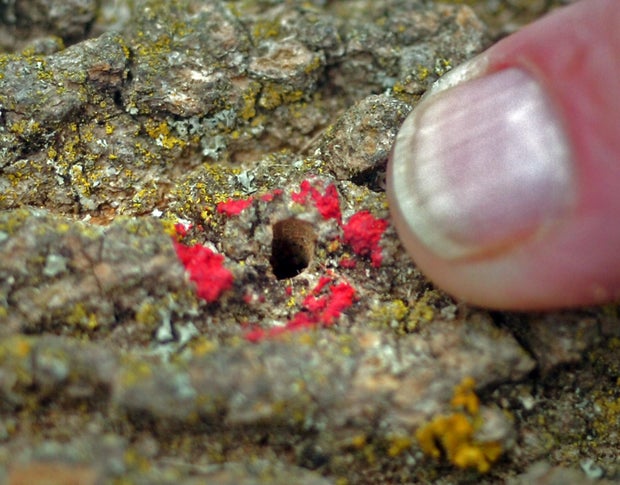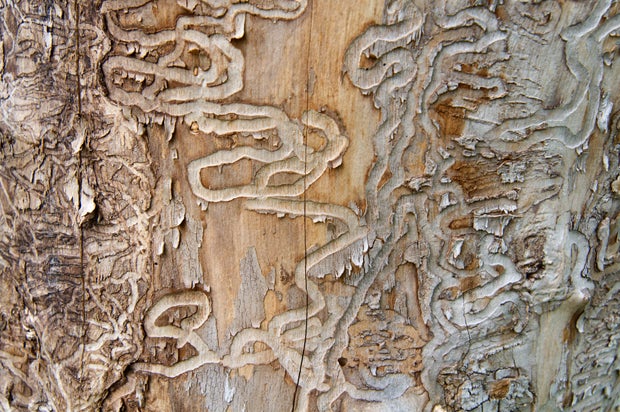A Colorado city is fighting to save tens of thousands of its trees from a “devastating” death. But it’s not deforestation or wildfires they are up against this time – it’s a tiny half-inch-long bug.
The city of Littleton, located just south of Denver, has been infiltrated by an Emerald Ash Borer, an exotic beetle that the city describes as a “pint-size insect” that “can cause king-size problems for ash trees.” These beetles are known for killing ash trees, which make up about 15% of all the city’s trees, about 45,000 trees.
Michael Sundberg, district manager for The Davey Tree Expert Company, told CBS Colorado that in Littleton, the pest could destroy “one in five trees” if preventative measures aren’t taken.
“They do a lot of tunneling under the bark and damage the tissue that carries the water and nutrients around the tree,” he said. “It’s kind of like the trees’ veins, so to speak, that get attacked.”
The Emerald Ash Borer Network says that once the beetles reach their adult stage, the metallic green bugs will eat up foliage on ash trees – their only food source. But it’s the larvae that eat up the inner bark of ash trees and prevent nutrients and water from circulating.
Once that happens, Littleton officials said the tree that’s been attacked becomes structurally unsound and will die within just a few years.

It’s believed that the insects were introduced to the U.S. from Asia after tagging along on solid wood packing material, the network said. They were first discovered in the U.S. near Detroit in 2002, and have since expanded to at least 35 states as well as at least five Canadian provinces. Ash trees will typically lose most of their canopy within two years of an infestation and die within three to four years, the National Invasive Species Information Center says.
Since the species’ discovery in the nation, they have “killed hundreds of millions of ash trees in North America,” the group added, and “cost municipalities property owners, nursery operators and forest products industries hundreds of millions of dollars.”
A major contributor to the bug’s pervasiveness is that it doesn’t have any natural predators in the U.S., Sundberg said.
“Ash has been heavily planted for the last 40 years so they’re everywhere,” he said. “So you have a high food source, nothing to really slow it down and it’s just a bad combination for a bug to just run wild and go crazy.”
The city has recommended the use of one of four insecticides that are taken up by the roots of the ash trees to prevent the bug’s spread: imidacloprid, dinotefuran, emamectin benzoate or azadirachtin. They also recommended that homeowners hire tree care professionals to administer the insecticides to all healthy trees that are in desirable locations. Otherwise, officials recommended removing and replacing the trees.
How to spot an Emerald Ash Borer infection
According to the USDA, Emerald Ash Borers have been called “The Green Menace,” and the insects have been found in Alabama, Arkansas, Colorado, Connecticut, Delaware, Georgia, Illinois, Indiana, Iowa, Kansas, Louisiana, Maryland, Massachusetts, Michigan, Minnesota, Missouri, Nebraska, New Hampshire, New Jersey, New York, North Carolina, Ohio, Oklahoma, Pennsylvania, Tennessee, Texas, Virginia, West Virginia and Wisconsin.
Littleton officials said that it can be difficult to difficult to determine if trees are infested with the beetles, but that symptoms of an attack include “sparse leaves or branches in the upper canopy, vertical splits in bark with S-shaped galleries beneath, smaller leaves at branch tips, D-shaped exit holes on branches, and epicormics shoots growing from the main trunk or near the center of the tree.”

The USDA says other signs of an infestation include yellow, thin or wilted foliage, an unusual woodpecker presence, and shoots growing from a tree’s roots or trunk with “larger-than-normal” leaves.
Sundberg said that if an infection is suspected in an area, people should refrain from moving around firewood or logs.
“Not traveling logs around is where you keep it from spreading fast from city to city. The bug can fly, but not super far,” he said. “…When it comes to jumping, I think they found it in Carbondale. The bug didn’t fly to Carbondale, it hitched a ride on some logs.”







